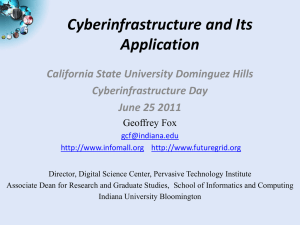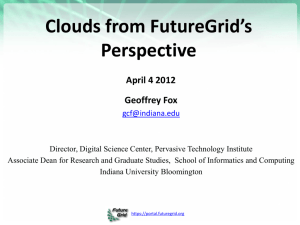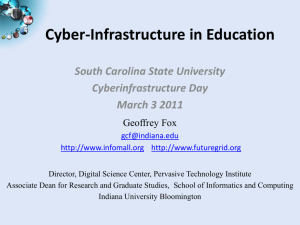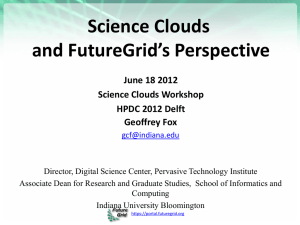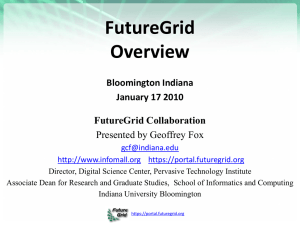Cyberinfrastructure and Its Application
advertisement
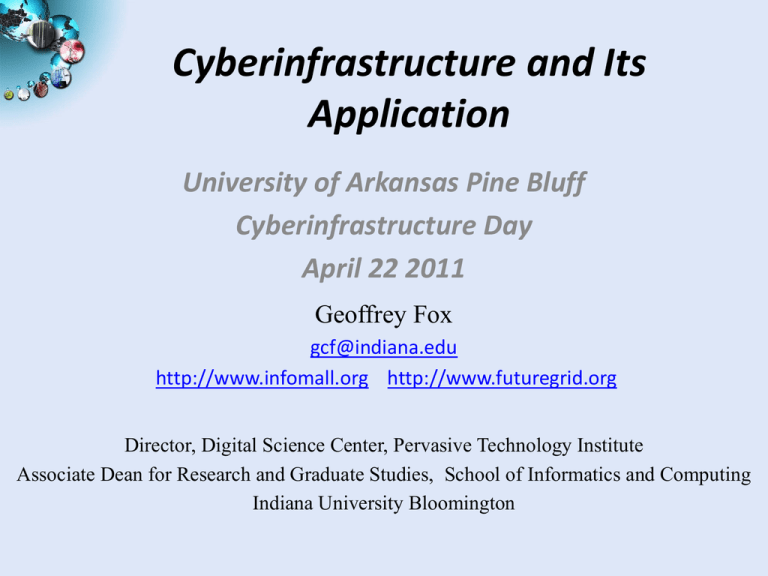
Cyberinfrastructure and Its Application University of Arkansas Pine Bluff Cyberinfrastructure Day April 22 2011 Geoffrey Fox gcf@indiana.edu http://www.infomall.org http://www.futuregrid.org Director, Digital Science Center, Pervasive Technology Institute Associate Dean for Research and Graduate Studies, School of Informatics and Computing Indiana University Bloomington Important Trends • Data Deluge in all fields of science • Multicore implies parallel computing important again – Performance from extra cores – not extra clock speed – GPU enhanced systems can give big power boost • Clouds – new commercially supported data center model replacing compute grids (and your general purpose computer center) • Light weight clients: Sensors, Smartphones and tablets accessing and supported by backend services in cloud • Commercial efforts moving much faster than academia in both innovation and deployment Big Data in Many Domains According to one estimate, we created 150 exabytes (billion gigabytes) of data in 2005. This year, we will create 1,200 exabytes PC’s have ~100 Gigabytes disk and 4 Gigabytes of memory Size of the web ~ 3 billion web pages: MapReduce at Google was on average processing 20PB per day in January 2008 During 2009, American drone aircraft flying over Iraq and Afghanistan sent back around 24 years’ worth of video footage http://www.economist.com/node/15579717 New models being deployed this year will produce ten times as many data streams as their predecessors, and those in 2011 will produce 30 times as many ~108 million sequence records in GenBank in 2009, doubling in every 18 months ~20 million purchases at Wal-Mart a day 90 million Tweets a day Astronomy, Particle Physics, Medical Records … Most scientific task shows CPU:IO ratio of 10000:1 – Dr. Jim Gray The Fourth Paradigm: Data-Intensive Scientific Discovery Large Hadron Collider at CERN; 100 Petabytes to find Higgs Boson 3 Jaliya Ekanayake - School of Informatics and Computing What is Cyberinfrastructure Cyberinfrastructure is (from NSF) infrastructure that supports distributed research and learning (e-Science, e-Research, eEducation) • Links data, people, computers Exploits Internet technology (Web2.0 and Clouds) adding (via Grid technology) management, security, supercomputers etc. It has two aspects: parallel – low latency (microseconds) between nodes and distributed – highish latency (milliseconds) between nodes Parallel needed to get high performance on individual large simulations, data analysis etc.; must decompose problem Distributed aspect integrates already distinct components – especially natural for data (as in biology databases etc.) 6 e-moreorlessanything ‘e-Science is about global collaboration in key areas of science, and the next generation of infrastructure that will enable it.’ from inventor of term John Taylor Director General of Research Councils UK, Office of Science and Technology e-Science is about developing tools and technologies that allow scientists to do ‘faster, better or different’ research Similarly e-Business captures the emerging view of corporations as dynamic virtual organizations linking employees, customers and stakeholders across the world. This generalizes to e-moreorlessanything including eDigitalLibrary, e-FineArts, e-HavingFun and e-Education A deluge of data of unprecedented and inevitable size must be managed and understood. People (virtual organizations), computers, data (including sensors and instruments) must be linked via hardware and software networks 7 The Span of Cyberinfrastructure High definition videoconferencing linking people across the globe Digital Library of music, curriculum, scientific papers Flickr, Youtube, Amazon …. Simulating a new battery design (exascale problem) Sharing data from world’s telescopes Using cloud to analyze your personal genome Enabling all to be equal partners in creating knowledge and converting it to wisdom Analyzing Tweets…documents to discover which stocks will crash; how disease is spreading; linguistic inference; ranking of institutions 8 Tracking the Heavens “The Universe is now being explored systematically, in a panchromatic way, over a range of spatial and temporal scales that lead to a more complete, and less biased understanding of its constituents, their evolution, their origins, and the physical processes governing them.” Hubble Telescope Palomar Telescope Towards a National Virtual Observatory Sloan Telescope SAN DIEGO SUPERCOMPUTER CENTER Fran Berman UNIVERSITY OF CALIFORNIA, SAN DIEGO Virtual Observatory Astronomy Grid Integrate Experiments Radio Far-Infrared Visible Dust Map Visible + X-ray 10 Galaxy Density Map Particle Physics at the CERN LHC UA1 at CERN 1981-1989 "hermetic detector" ATLAS at LHC, 2006-2020 150*106 sensors LHC experimental collaborations (e.g. ATLAS) typically involve over 100 institutes and over 1000 physicists11world wide European Grid Infrastructure Status April 2010 (yearly increase) • 10000 users: +5% • 243020 LCPUs (cores): +75% • 40PB disk: +60% • 61PB tape: +56% • 15 million jobs/month: +10% • 317 sites: +18% • 52 countries: +8% • 175 VOs: +8% • 29 active VOs: +32% 1/10/2010 EGI-InSPIRE RI-261323 NSF & EC - Rome 2010 12 www.egi.eu TeraGrid Example: Astrophysics • Science: MHD and star formation; cosmology at galactic scales (6-1500 Mpc) with various components: star formation, radiation diffusion, dark matter • Application: Enzo (loosely similar to: GASOLINE, etc.) • Science Users: Norman, Kritsuk (UCSD), Cen, Ostriker, Wise (Princeton), Abel (Stanford), Burns (Colorado), Bryan (Columbia), O’Shea (Michigan State), Kentucky, Germany, UK, Denmark, etc. DNA Sequencing Pipeline Illumina/Solexa Roche/454 Life Sciences Applied Biosystems/SOLiD Internet ~300 million base pairs per day leading to ~3000 sequences per day per instrument ? 500 instruments at ~0.5M$ each Read Alignment Pairwise clustering FASTA File N Sequences Blocking Form block Pairings Sequence alignment Dissimilarity Matrix MPI N(N-1)/2 values MDS MapReduce Visualization Plotviz 100,043 Metagenomics Sequences ECSU Cyberinfrastructure Day Linda Hayden Lightweight Cyberinfrastructure to support mobile Data gathering expeditions plus classic central resources (as a cloud) 17 See talk by Je’aime Powell ECSU Hidden Markov Method based Layer Finding P. Felzenszwalb, O. Veksler, Tiered Scene Labeling with Dynamic Programming, IEEE Conference on Computer Vision and Pattern Recognition (CVPR), 2010 Use of Tiled Screens ADMI Cloudy View on Computing Workshop Summer 2011 Jerome Mitchell: Undergraduate ECSU, Masters Kansas, PhD Indiana Data Centers Clouds & Economies of Scale I Range in size from “edge” facilities to megascale. Economies of scale Approximate costs for a small size center (1K servers) and a larger, 50K server center. 2 Google warehouses of computers on Technology in smallCost in Large Ratio the banks ofCost the sized Data Columbia Data Center River, in The Dalles, Center Oregon Network $95 per Mbps/ $13 per Mbps/ 7.1 Such centers use 20MW-200MW month month Storage $2.20 per GB/ 150 $0.40 per GB/ 5.7 CPU (Future) each with watts per month month Save money~140from large size, 7.1 Administration servers/ >1000 Servers/ Administrator positioning Administrator with cheap power and access with Internet Each data center is 11.5 times the size of a football field Data Centers, Clouds & Economies of Scale II • Builds giant data centers with 100,000’s of computers; ~ 200-1000 to a shipping container with Internet access • “Microsoft will cram between 150 and 220 shipping containers filled with data center gear into a new 500,000 square foot Chicago facility. This move marks the most significant, public use of the shipping container systems popularized by the likes of Sun Microsystems and Rackable Systems to date.” 22 X as a Service • SaaS: Software as a Service imply software capabilities (programs) have a service (messaging) interface – Applying systematically reduces system complexity to being linear in number of components – Access via messaging rather than by installing in /usr/bin • IaaS: Infrastructure as a Service or HaaS: Hardware as a Service – get your computer time with a credit card and with a Web interface • PaaS: Platform as a Service is IaaS plus core software capabilities on which you build SaaS • Cyberinfrastructure is “Research as a Service” Other Services Clients Sensors as a Service Cell phones are important sensor Sensors as a Service Sensor Processing as a Service (MapReduce) Clouds and Jobs • Clouds are a major industry thrust with a growing fraction of IT expenditure that IDC estimates will grow to $44.2 billion direct investment in 2013 while 15% of IT investment in 2011 will be related to cloud systems with a 30% growth in public sector. • Gartner also rates cloud computing high on list of critical emerging technologies with for example “Cloud Computing” and “Cloud Web Platforms” rated as transformational (their highest rating for impact) in the next 2-5 years. • Correspondingly there is and will continue to be major opportunities for new jobs in cloud computing with a recent European study estimating there will be 2.4 million new cloud computing jobs in Europe alone by 2015. • Cloud computing is an attractive for projects focusing on workforce development. Note that the recently signed “America Competes Act” calls out the importance of economic development in broader impact of NSF projects Cloud Computing Transformational Cloud Web Platforms Media Tablet High Moderate Low Gartner 2009 Hype Curve Clouds, Web2.0 Service Oriented Architectures Workshop Details • Who: – > 10-12 Association of Computer/Information Sciences and Engineering Departments at Minority Institutions (ADMI) faculty/students • Where: – Elizabeth City State University (ECSU) • When: – June 7 - July 5 2011 • What: – A Teach - One - Teach - Many approach to cloud computing • Preliminary discussion on workshop at ADMI 2011 Conference (April 14-16, 2011) Workshop Purpose • Introduce ADMI to the basics of the emerging Cloud Computing paradigm – Learn how it came about – Understand its enabling technologies – Understand the computer systems constraints, tradeoffs, and techniques of setting up and using cloud • Teach ADMI how to implement algorithms in the Cloud – Gain competence in cloud programming models for distributed processing of large datasets. – Understand how different algorithms can be implemented and executed on cloud frameworks – Evaluating the performance and identifying bottlenecks when mapping applications to the clouds Exploit electronic infrastructure to enhance learning • Several quite old approaches are critical and dominant – “Just a bunch of web pages” aka digital library – Video conferencing – Shared material as in Webex, Adobe Connect • Note asynchronous interaction via Twitter, Blackboard, Google docs etc. much easier (and successful) than synchronous (Polycom, access grid, Webex) approaches • Interactive web learning environments such as www.whyville.net • Virtual worlds such as Second Life have not taken off but some think this will change as performance of clients and networks are improving dramatically (VRML failed ~1999) • Must move to an environment consistent with world view of current students aka the “Twitter University” Some Indiana Next Steps • Develop Appliances (Virtual machine based preconfigured computer systems) to support programming laboratories • Offer Cloud Computing course with – Web portal support – FutureGrid or Appliances locally – Distance delivery • Deliver first to ECSU, then other ADMI Schools US Cyberinfrastructure Context • There are a rich set of facilities – Production TeraGrid facilities with distributed and Talk by Jim Ferguson shared memory – Experimental “Track 2D” Awards • FutureGrid: Distributed Systems experiments cf. Grid5000 • Keeneland: Powerful GPU Cluster • Gordon: Large (distributed) Shared memory system with SSD aimed at data analysis/visualization – Open Science Grid aimed at High Throughput computing and strong campus bridging 31 FutureGrid key Concepts I • FutureGrid is a 4 year $15M project with 7 clusters at 5 sites across country with 8 funded partners • FutureGrid is a flexible testbed supporting Computer Science and Computational Science experiments in – Innovation and scientific understanding of distributed computing (cloud, grid) and parallel computing paradigms – The engineering science of middleware that enables these paradigms – The use and drivers of these paradigms by important applications – The education of a new generation of students and workforce on the use of these paradigms and their applications – interoperability, functionality, performance or evaluation https://portal.futuregrid.org FutureGrid key Concepts II • Rather than loading images onto VM’s, FutureGrid supports Cloud, Grid and Parallel computing environments by dynamically provisioning software as needed onto “bare-metal” – Image library for MPI, OpenMP, Hadoop, Dryad, gLite, Unicore, Globus, Xen, ScaleMP (distributed Shared Memory), Nimbus, Eucalyptus, OpenNebula, KVM, Windows ….. • Growth comes from users depositing novel images in library • Each use of FutureGrid is an experiment that is reproducible • Developing novel software to support these goals which build on Grid5000 in France Image1 Choose Image2 … ImageN Load https://portal.futuregrid.org Run FutureGrid Partners • Indiana University (Architecture, core software, Support) • Purdue University (HTC Hardware) • San Diego Supercomputer Center at University of California San Diego (INCA, Monitoring) • University of Chicago/Argonne National Labs (Nimbus) • University of Florida (ViNE, Education and Outreach) • University of Southern California Information Sciences (Pegasus to manage experiments) • University of Tennessee Knoxville (Benchmarking) • University of Texas at Austin/Texas Advanced Computing Center (Portal) • University of Virginia (OGF, Advisory Board and allocation) • Center for Information Services and GWT-TUD from Technische Universtität Dresden. (VAMPIR) • Red institutions have FutureGrid hardware https://portal.futuregrid.org FutureGrid: a Grid/Cloud/HPC Testbed NID: Network Impairment Device Private FG Network Public https://portal.futuregrid.org 5 Use Types for FutureGrid • Training Education and Outreach – Semester and short events; promising for outreach • Interoperability test-beds – Grids and Clouds; OGF really needed this • Domain Science applications – Life science highlighted • Computer science – Largest current category • Computer Systems Evaluation – TeraGrid (TIS, TAS, XSEDE), OSG, EGI https://portal.futuregrid.org 36 Education & Outreach on FutureGrid • Build up tutorials on supported software • Support development of curricula requiring privileges and systems destruction capabilities that are hard on conventional TeraGrid • Offer suite of appliances (customized VM based images) supporting online laboratories • Supporting several workshops including Virtual Summer School on “Big Data” July 26-30 2010; TeraGrid ‘10 “Cloud technologies, dataintensive science and the TG” August 2010; CloudCom conference tutorials Nov 30-Dec 3 2010 • Experimental class use at Indiana, Florida and LSU • ADMI Summer 2011 School on Clouds and REU program for Minority Serving Institutions https://portal.futuregrid.org

